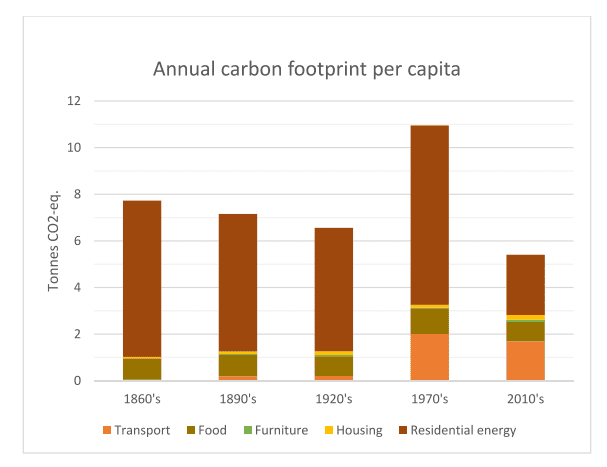Pioneering historical LCA – A perspective on the development of personal carbon footprint 1860–2020 in Denmark

Mitigating climate change by reducing anthropogenic greenhouse gas emissions is considered an urgent challenge for society. In this context, different philosophies exist. A classic debate, referred to as “boomsters vs. doomsters”, asks whether humanity’s drive for technological innovations will mitigate climate change, or whether it is justifiable to compromise our living standards, affluence, and consumption patterns. A Danish research project has elucidated this topic through cross-collaboration between historians and engineers by quantifying the personal consumption-based carbon footprint (CF) of Danish citizens, taking into account the consumption segments of food, transport, housing, and furniture.
Quantification is conducted through life-cycle assessments (LCA) of five decadal timesteps during the period 1860–2020. As only one other study conducting historical (retrospective) LCA with an extensive time horizon was identified in the scientific literature, our own study provides novel insights by exploring possible approaches in this field. Historical LCA has many similarities with prospective (future) LCA, providing inspiration to the approach. The main challenge of the study is to adjust both foreground and background systems in the inventory modelling phase. Data is largely based on national statistics, books, museum case studies, expert testimonials, and proxies such as using the steam turbine as an indicator of improvements to technological efficiency over time. The results show a slightly declining carbon footprint in the period 1860–1930, from 7.7 to 6.6 t CO2-eq per capita annually.
Unsurprisingly the footprint peak is not found until the 1970s, at 11 t, reducing to 5.4 t in the 2010s. The residential energy consumption segment contributes half of this CF, followed by transportation by road and rail. Discussion of the results shows that whether technology can mitigate the impact from the increase in affluence depends on the specific consumption segment. For housing combined with residential energy, the results show that technology can mitigate increases in CF, despite the comforts of home having only increased over time. For the transportation segment, however, the past century has seen an eightfold increase in CF due to the pronounced evolution of personal modes of transportation. The findings suggests that the “boomsters vs. doomsters” debate is not so black and white after all. We further suggest that historical LCA, in tandem with prospective LCA, can provide valuable insights for decision support to facilitate a green transition and hence a green future.
